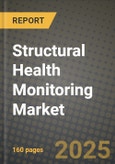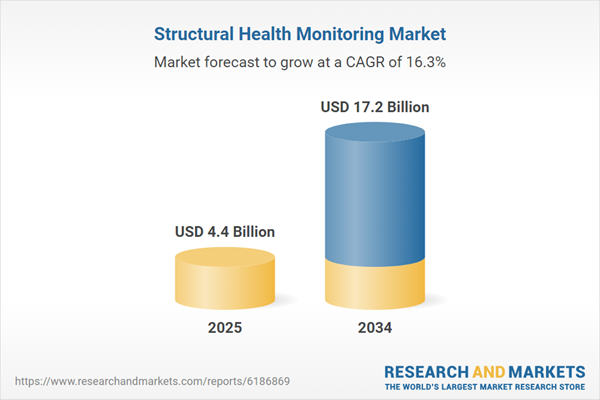The structural health monitoring (SHM) market involves the use of advanced technology to assess and monitor the condition of structures such as bridges, buildings, dams, and other critical infrastructure. SHM systems are equipped with sensors and data analysis tools that continuously collect data on the physical condition of structures to detect potential issues, such as cracks, vibrations, or material fatigue. These systems help prevent costly repairs and improve safety by providing real-time data to maintenance teams. The market has gained significant traction due to the increasing need for infrastructure maintenance, particularly in aging infrastructure in developed countries. With the rise of smart cities and increased urbanization, SHM has become essential for ensuring the safety and sustainability of infrastructure. Technological advancements, including the use of IoT (Internet of Things) sensors, wireless networks, and data analytics, have contributed to the growth of this market. SHM allows for predictive maintenance, reducing downtime and prolonging the life of infrastructure assets. The market is also being driven by regulatory pressures for safety and efficiency, particularly in sectors like construction, transportation, and energy, where infrastructure integrity is critical to both economic and public safety.
The SHM market saw several important developments, particularly with the integration of advanced technologies like AI, machine learning, and 5G connectivity. These innovations enabled the collection, processing, and analysis of vast amounts of real-time data more effectively and with greater accuracy. AI and machine learning algorithms allowed for more sophisticated predictive maintenance, helping operators anticipate issues before they occurred, thus reducing unexpected failures and costly repairs. Additionally, the adoption of wireless and remote monitoring technologies gained traction, making it easier for infrastructure managers to access real-time data and remotely manage their assets. The transportation and energy sectors were major drivers of SHM adoption, as governments and companies sought to modernize infrastructure and ensure the continued safety of vital assets. In the transportation sector, for instance, SHM systems were deployed to monitor the condition of bridges, tunnels, and railways. However, high initial investment costs and concerns about data security remained significant barriers to widespread SHM adoption. Despite these challenges, the market continued to grow as the long-term benefits of SHM, including improved safety, efficiency, and cost savings, became more widely recognized.
The SHM market is expected to continue expanding as more industries embrace smart infrastructure solutions. With the increasing focus on sustainability and the growing need to preserve aging infrastructure, SHM is poised to become even more critical in maintaining the integrity of public and private assets. As sensor technology continues to improve and become more affordable, SHM systems will be more widely deployed in a broader range of sectors, including construction, water management, and manufacturing. The integration of SHM with building information modeling (BIM) will provide comprehensive insights into the condition of infrastructure, further improving decision-making processes. Additionally, the use of drones and robotic systems for visual inspection and data collection will become more prevalent, improving the efficiency of inspections and reducing the need for manual labor. The increasing adoption of 5G networks will allow for faster data transmission, enabling real-time monitoring in remote locations, further driving the market. However, challenges related to the high costs of implementing SHM systems and the complexity of integrating these solutions into existing infrastructure will likely continue to impact the pace of market adoption.
Key Insights: Structural Health Monitoring Market
- Integration of AI and machine learning technologies to enhance predictive maintenance and improve the accuracy of data analysis.
- Adoption of wireless and remote monitoring systems that enable real-time data access and reduce the need for on-site inspections.
- Increased deployment of SHM systems in the transportation and energy sectors, where infrastructure safety and reliability are critical.
- Growth in the use of drones and robotic systems for visual inspections and data collection, improving the efficiency of monitoring processes.
- Integration of SHM with building information modeling (BIM) to provide a comprehensive view of infrastructure conditions and enhance decision-making.
- The rising demand for predictive maintenance and the need to extend the lifespan of aging infrastructure assets.
- Technological advancements, including the adoption of AI, IoT, and 5G networks, which enhance the capabilities of SHM systems.
- The increasing focus on infrastructure safety and sustainability, driven by government regulations and public safety concerns.
- The growing need to reduce maintenance costs and prevent costly repairs through proactive monitoring and early detection of potential issues.
- High initial costs of implementing SHM systems and challenges associated with integrating them into existing infrastructure, which may slow down market adoption.
Structural Health Monitoring Market Segmentation
By Component
- Hardware
- Software
- Services
By Connectivity
- Wired
- Wireless
By Application
- Bridges and Dams
- Buildings and Stadiums
- Vessels and Platforms
- Airframes and Wind Turbines
- Large Machinery and Equipment
By End User
- Civil
- Aerospace
- Defense
- Energy
- Mining
- Other End Users
Key Companies Analysed
- Nova Ventures Group Corp.
- Geokon
- Campbell Scientific Inc.
- COWI A/S
- Geocomp Corporation
- Acellent Technologies Inc.
- Sixense
- Structural Monitoring Systems Plc
- Digitexx Data Systems Inc.
- Kinemetrics
- National Instruments Corporation
- Hottinger Baldwin Messtechnik GmbH
- SGS Société Générale de Surveillance SA
- James Fisher Strainstall
- Advitam Inc.
- Strainstall Limited
- Pure Technologies
- RST Instruments Ltd.
- Smart Structures Inc.
- Abaqus Technologies Inc.
- Hexagon AB
- Hottinger Bruel & Kjaer (HBK) Test and Measurement
- General Electric (GE) Sensing & Inspection Technologies
- Dynastar SAS
- DRS Technologies
- Acellent Technologies
- B&K Vibro
- ASI Technologies
- Applied Acoustic Systems
- Agilent Technologies.
Structural Health Monitoring Market Analytics
The report employs rigorous tools, including Porter’s Five Forces, value chain mapping, and scenario-based modeling, to assess supply-demand dynamics. Cross-sector influences from parent, derived, and substitute markets are evaluated to identify risks and opportunities. Trade and pricing analytics provide an up-to-date view of international flows, including leading exporters, importers, and regional price trends.Macroeconomic indicators, policy frameworks such as carbon pricing and energy security strategies, and evolving consumer behavior are considered in forecasting scenarios. Recent deal flows, partnerships, and technology innovations are incorporated to assess their impact on future market performance.
Structural Health Monitoring Market Competitive Intelligence
The competitive landscape is mapped through proprietary frameworks, profiling leading companies with details on business models, product portfolios, financial performance, and strategic initiatives. Key developments such as mergers & acquisitions, technology collaborations, investment inflows, and regional expansions are analyzed for their competitive impact. The report also identifies emerging players and innovative startups contributing to market disruption.Regional insights highlight the most promising investment destinations, regulatory landscapes, and evolving partnerships across energy and industrial corridors.
Countries Covered
- North America - Structural Health Monitoring market data and outlook to 2034
- United States
- Canada
- Mexico
- Europe - Structural Health Monitoring market data and outlook to 2034
- Germany
- United Kingdom
- France
- Italy
- Spain
- BeNeLux
- Russia
- Sweden
- Asia-Pacific - Structural Health Monitoring market data and outlook to 2034
- China
- Japan
- India
- South Korea
- Australia
- Indonesia
- Malaysia
- Vietnam
- Middle East and Africa - Structural Health Monitoring market data and outlook to 2034
- Saudi Arabia
- South Africa
- Iran
- UAE
- Egypt
- South and Central America - Structural Health Monitoring market data and outlook to 2034
- Brazil
- Argentina
- Chile
- Peru
Research Methodology
This study combines primary inputs from industry experts across the Structural Health Monitoring value chain with secondary data from associations, government publications, trade databases, and company disclosures. Proprietary modeling techniques, including data triangulation, statistical correlation, and scenario planning, are applied to deliver reliable market sizing and forecasting.Key Questions Addressed
- What is the current and forecast market size of the Structural Health Monitoring industry at global, regional, and country levels?
- Which types, applications, and technologies present the highest growth potential?
- How are supply chains adapting to geopolitical and economic shocks?
- What role do policy frameworks, trade flows, and sustainability targets play in shaping demand?
- Who are the leading players, and how are their strategies evolving in the face of global uncertainty?
- Which regional “hotspots” and customer segments will outpace the market, and what go-to-market and partnership models best support entry and expansion?
- Where are the most investable opportunities - across technology roadmaps, sustainability-linked innovation, and M&A - and what is the best segment to invest over the next 3-5 years?
Your Key Takeaways from the Structural Health Monitoring Market Report
- Global Structural Health Monitoring market size and growth projections (CAGR), 2024-2034
- Impact of Russia-Ukraine, Israel-Palestine, and Hamas conflicts on Structural Health Monitoring trade, costs, and supply chains
- Structural Health Monitoring market size, share, and outlook across 5 regions and 27 countries, 2023-2034
- Structural Health Monitoring market size, CAGR, and market share of key products, applications, and end-user verticals, 2023-2034
- Short- and long-term Structural Health Monitoring market trends, drivers, restraints, and opportunities
- Porter’s Five Forces analysis, technological developments, and Structural Health Monitoring supply chain analysis
- Structural Health Monitoring trade analysis, Structural Health Monitoring market price analysis, and Structural Health Monitoring supply/demand dynamics
- Profiles of 5 leading companies - overview, key strategies, financials, and products
- Latest Structural Health Monitoring market news and developments
Additional Support
With the purchase of this report, you will receive:- An updated PDF report and an MS Excel data workbook containing all market tables and figures for easy analysis.
- 7-day post-sale analyst support for clarifications and in-scope supplementary data, ensuring the deliverable aligns precisely with your requirements.
- Complimentary report update to incorporate the latest available data and the impact of recent market developments.
This product will be delivered within 1-3 business days.
Table of Contents
Companies Mentioned
- Nova Ventures Group Corp.
- Geokon
- Campbell Scientific Inc.
- COWI A/S
- Geocomp Corporation
- Acellent Technologies Inc.
- Sixense
- Structural Monitoring Systems PLC
- Digitexx Data Systems Inc.
- Kinemetrics
- National Instruments Corporation
- Hottinger Baldwin Messtechnik GmbH
- SGS Société Générale de Surveillance SA
- James Fisher Strainstall
- Advitam Inc.
- Strainstall Limited
- Pure Technologies
- RST Instruments Ltd.
- Smart Structures Inc.
- Abaqus Technologies Inc.
- Hexagon AB
- Hottinger Bruel & Kjaer (HBK) Test and Measurement
- General Electric (GE) Sensing & Inspection Technologies
- Dynastar SAS
- DRS Technologies
- Acellent Technologies
- B&K Vibro
- ASI Technologies
- Applied Acoustic Systems
- Agilent Technologies .
Table Information
| Report Attribute | Details |
|---|---|
| No. of Pages | 160 |
| Published | October 2025 |
| Forecast Period | 2025 - 2034 |
| Estimated Market Value ( USD | $ 4.4 Billion |
| Forecasted Market Value ( USD | $ 17.2 Billion |
| Compound Annual Growth Rate | 16.3% |
| Regions Covered | Global |
| No. of Companies Mentioned | 30 |









